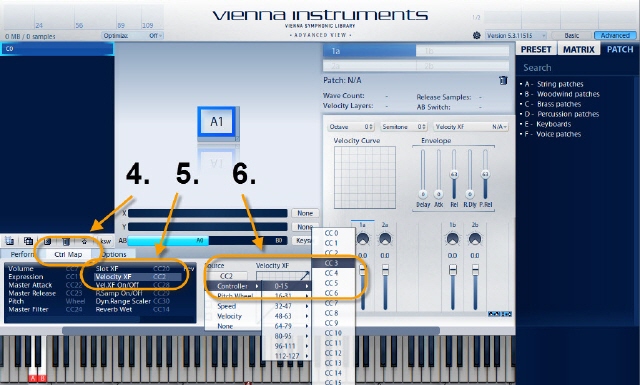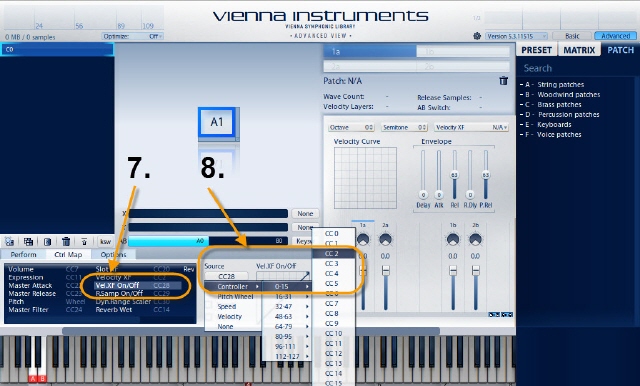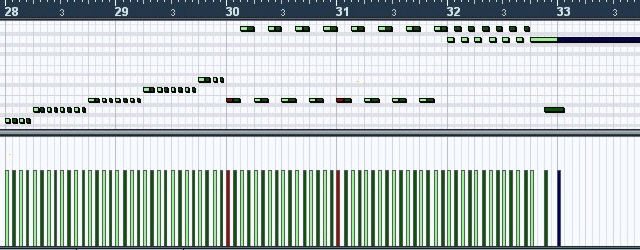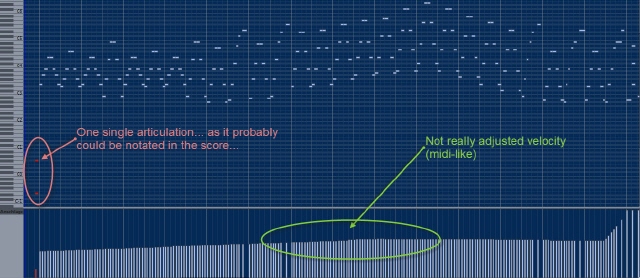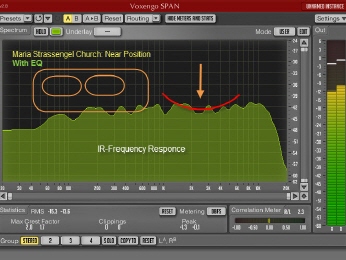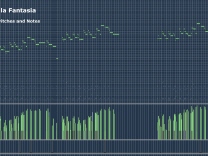VI TIPS & TRICKS B
Contents
29. Combining String Libraries
30. How to use (install) the Velocity-X-Fader?
31. How to improve the play of strings with samples?
32. How to improve "Mixing an Orchestra"
33. Varying the velocity can kill the "Gun-Effect"
34. Music with samples = vary Tempo, Velocity, Articul...
35. Stereoenhancer after Convolution Reverbs?
36. Convolution Reverbs: EQ the sound of IRs
37. How to play a lot of 16ths more interesting?
38. Sound-Comparison: CH-Strings <> D-Strings
39. Using different short articulations for natural sounding instruments
40. Compare the sound of VSL's Violine 1 & Violine 2 (solo Strings VI)
41. Compare the sound of VSL's Violine 1 & Violine 2 (solo Strings VI)
42. Video about using depths for mixing orchestras
- 29.
- 30.
- 31.
- 32.
- 33.
- 34.
- 35.
- 36.
- 37.
- 38.
- 39.
- 40.
- 41.
- 42.
Combining String Libraries
One could assume that combing strings would enlarge the ensemble even more.
For example: Let's play the 20 Violins (Appassionatas) and the 6 Chamber Violins = 26 Violins in total...
The amount of Violins is correct but the resulting sound is a mix between the two sounds. On the one hand we still have the large ensemble but on the other hand we get back a bit of the closeness, the warmth, the vibrato and other positive properties of the Chamber Strings.
So by combining different Strings Libraries we can revive bigger ensembles by smaller ones. We so to say breathe a bit more life into large ensembles. Simply play the same voices with the libraries you want to use for combining as well and add them to the sound of the appassionatas for example.
Listen to the following example.
By pressing "Play" and "Pause" with the two Players you can easily compare smaller sequences.
Especially the high registers got a bit more vibrato, breathe and liveliness. Nevertheless, we have a large ensemble.
How to use (install) the Velocity-X-Fader?
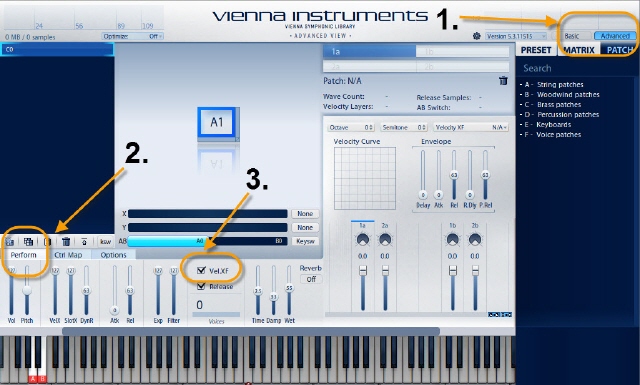
1. Click "ADVANCED"
2. "Perform"
3. Activate X-Velocity at "Vel.XF"
You still will be able to swich on and off "X-Velocity" with a controller (DAW)
Click on the image...
How to improve a more natural playing of strings with samples?
Have one lesson from a violinist
- He shall show you all the possible articulations.
- He shall show you how long you can play with on length of the bow.
- He shall show you the preparing of a score (drawing in the signs "up and down" for the bow.
- He shall show you which things would be difficult (or impossible) to play with a violin.
- Let him play a piece of you for getting an idea how a violin player approaches new pieces.
- Try to translate the experiences into the world of samples.
- After that visit the violinist once more with your sample version. Let him improve your result.
Visit concerts. Sit within the first row. A)
- Observe the string players (bow changes).
- Observe how often the musicians change the bow (it's very often).
- Try to simulate this fact as well with your samples (see also VI TIPS & TRICKS 3 No 21. / No 26.).
Visit concerts. Sit within the first row. B)
- Try to memory the sound: Do the strings sound closer than the woodwinds, the brass.
- Try to distinguish how much of the reaching sound is reverb and how much could be direct sound. 1:1? 1:2?
- Try to find out how much closer a soloist sounds than the rest of the orchestra.
- Sit on the balcony another time (far away). Observe the upper mentioned matters. Differences?
- Try to integrate your live-experiences into your mixes.
Which is/was your favourite sound?
Combine Strings-Libraries (playing unisono)
- Orchestra with Chamber
- Orchestra with Solo
- Chamber with Solo
- Appassionata with Chamber
- Appassionata with Solo
you will get an even more rich sound.
Use these tips for other instruments as well
How to improve "Mixing an Orchestra"

Listen to a lot of orchestras and mixes until you find the one you would like to copy its sound.
Observe the depths which are used / try to draw the stage with the instruments / try to find out more about the sound of the used instruments.
After all you can try to achieve a similar mix. Even if you will never reach your reference you will make steps foreward in mixing orchestras.
As an example: This is the newest mix of the "Celtic Woman" (CD Home for Christmas). http://www.youtube.com/watch?v=Mtu1-YjlW5c
The mix was done in 2012. You will hear the Atlanta Symponic Orchestra with harp, choir, percussion and a sort of soloists (Celtic Ladies)
The music style is something between classical music, light music and pop. So the sound is probably a bit tuned compared with classical mixes.
Nevertheless, we use this tuning aspects as well with our samples - specially when we compose for films etc.
So it isn't important whether you like the music style or not. The example stands just for observing the mixing aspects.
- What about the depths (which instrument sounds where)
- What about left and right
- What about the sound of the strings? bright? dark?
- How do the brass instruments sound ? What about left and right of those instruments?
- Where are the singers placed.
- What about the bass? Does it sound strong and powerfull? Why? Plays it alone in its range?
- What about the timpany? does it support the bass voice or not really?
- Does the mix sound clear and transparent? Also during tutti parts? If yes, why?
Varying the velocity can kill the "Gun-Effect"

This tip is based on a sequence like you have with Handel’s Aria from Messiah: "Why do the nations". The orchestra plays only fast staccatos. So you have a repetition of this sample type hundreds of times. Take repetition samples if possible (spiccatos). You will have the advantage of really no gun effect.
But even if you are going to take single staccato samples you have "a chance"...
Part 1, Part 2, all strings together...
So if you apply this different velocties to all the staccato notes you can avoid this "Machine-Gun-Effect" very good.
Listen no to the whole result...
How to fight against cold, boring, steril and static music with samples?
The following two example will show the difference.
Even if the music is lively it is even better to vary Tempo / Articulations / Velocity / Dynamic whenever it is possible for getting a result closer to the reality:
Example A)
Example B)
Comment:
Maybe both of the examples are a bit "over-(under-)done". But Example A) shows how most of the music with samples comes along specially when it is played by score programs.
StereoEnhancer effects after Convolution Reverbs?
First of all: You always should do the enhancing process with monitors.
Why I personally advise against using stereo enhancers in connection with Convolution Reverbs?
There is for example a microphone method called ORTF. Two Mics, 110° angle, 17cm distance. Recording with this empirically founded "stereo arrangemend" leads to a very roomy sound and you also get the depths of instruments nicely back over speakers and headphones.
Using a stereo enhancer together with such a recorded track you can completely destroy this nice stereo impression. The following example shows how you lose the nice depths and the well recognizable places from left to the right with ORTF microphones.
Now the same recording with a stereoenhancer-effect (a bit overdone of course)
My observation:
At a first glance the second result seem to sound "better".
But if you are listen a bit longer (also with monitors) it is clear that the enhancer effect kills the precise information about the position of instruments.
Good IRs are often made with care and also with a certain microphone procedure.
So using stereoenhancers with good IRs can destroy the natural sound of them.
In other words:
Use the stereo enhancer gently and with caution in connection with convolution reverbs.
It is maybe better to use another IR which comes with the width you wish.
And of course as always: Less (effects) could be more.
Finally: As mentioned above, the correlation measurement is a great help for not doing too much.
Convolution Reverbs: EQ the sound of IRs
IRs (Impulse Responses) of certain rooms have sometimes a sound coloration which makes the music a bit muddy, boomy or what ever.
You can solve the problem with the built in EQ of the Convolution Reverb.
Let me show this matter with the IR of the "Maria Strassengel Church": When we play a "pink noise signal" through the Convolution Reverb and we adjust to "100% wet" we can see where "the problems" are... Use then the built in EQ for equalize the "hills and valleys"
This is the sound before the correction - a bit "blowed up"?
This is the sound after the correction
Listen once to the upper player - press Pause - and then to the lower one. You can nicely compare section by section.
Compare for example 00:09 - 00:18 and of course other sections.
How to play a lot of 16ths more interesting?
This piece by Paganini "Perpetuo" uses this technique throughout. This means a great effort, of course, because every, really every! note has to be touched in order to achieve an individual loudness (velocity and additionally each upstroke of the violins has to be a little bit quieter than the downstroke note before...
Sound-Comparison: Chamberstrings <> Dimension-Strings
Using different short articulations...
... for natural sounding instruments

A real instrument player plays each new note with another articulation even if he only wants to play staccato for example.
We have the problem that all the notes and articulations should sound as neutral as possible with samples. Notes with integrated feelings would be great the very first time we hear it - but as soon we have the second tone with the same feeling as before it would appear horrible more and more with every new repetition.
So it is up to us to bring life into the death sounding world of samples by varying the tempo, the velocity, the dynamic and of course the articulations as often as possible.
Varying the articulation is a first big step forward to a natural feeling!
The following PDF and the belonging music example will show you this beautifully!
Download: bk_articulation_demos.pdf [195 KB]
Listen to the classical demos in the demo section. I follow this rule: "Change the articulation as often as possible!"
VSL Solo-Violin-Library "sViolin1 & 2"
Compare the Violins with "Danz, Danza": It shows more the fast and hard sound qualities. "40."
Compare the Violins with "Nella Fantasia": It shows the more slow and soft sound qualities. >>> see at "41."
About the used effects...
Both violins got the same effects:
Stereo-Effect, Compressor, Reverb, EQ just for enhancing the highend but not for "composing a new sound"
I only used an Algorithmic Reverb for the violins - so no additional "room-color" from a certain IR.
!!! I tried to offer the most neutral sound of both Libraries !!!
First I played the demo with "Violin 1" and used a lot of articulations:
Staccato, Leg-Spiccato, Leg-Marcato, Leg-Harsh, Leg-Trills, Dim 4s, Spiccato-Runs, sfz, Leg-Portato, Leg-Zigane, Repetions-legato, Détaché long, Sustain and more...
Then I played it with the "Violine 2"... Unfortunately the library does not contain the same amount of articulations.
Not included are for example: Leg-Marcato, Leg-Harsh, Leg-Spiccato, Runs, Zigane... Nevertheless: I replaced those lacking articulations with similar sounding ones. Spic =Stac, Harsh = Stac (fff) etc. and the result was quite similar.
VSL - VIOLIN 1
VSL - VIOLIN 2
VSL Solo-Violin-Library "sViolin1 & 2"
Compare the Violins with "Nella Fantasia": It shows the more slow and soft sound qualities. "41."
Compare the Violins with "Danz, Danza": It shows more the fast and hard sound qualities. >>> see at "40."
About the used effects...
Both violins got the same effects:
Stereo-Effect, Compressor, Reverb, EQ just for enhancing the highend but not for "composing a new sound"
I only used an Algorithmic Reverb for the violins - so no additional "room-color" from a certain IR.
!!! I tried to offer the most neutral sound of both Libraries !!!
VSL - VIOLIN 1
VSL - VIOLIN 2
Download the empty stage used in the video as pdf >>> here.
© Copyright, Createc Beat Kaufmann, 2004 - 2025
